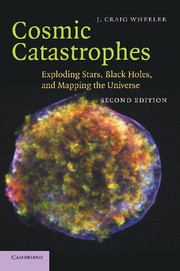Book contents
- Frontmatter
- Contents
- Preface
- 1 Setting the stage: star formation and hydrogen burning in single stars
- 2 Stellar death: the inexorable grip of gravity
- 3 Dancing with stars: binary stellar evolution
- 4 Accretion disks: flat stars
- 5 White dwarfs: quantum dots
- 6 Supernovae: stellar catastrophes
- 7 Supernova 1987A: lessons and enigmas
- 8 Neutron stars: atoms with attitude
- 9 Black holes in theory: into the abyss
- 10 Black holes in fact: exploring the reality
- 11 Gamma-ray bursts, black holes and the Universe: long, long ago and far, far away
- 12 Supernovae and the Universe
- 13 Wormholes and time machines: tunnels in space and time
- 14 Beyond: the frontiers
- Index
9 - Black holes in theory: into the abyss
Published online by Cambridge University Press: 14 September 2009
- Frontmatter
- Contents
- Preface
- 1 Setting the stage: star formation and hydrogen burning in single stars
- 2 Stellar death: the inexorable grip of gravity
- 3 Dancing with stars: binary stellar evolution
- 4 Accretion disks: flat stars
- 5 White dwarfs: quantum dots
- 6 Supernovae: stellar catastrophes
- 7 Supernova 1987A: lessons and enigmas
- 8 Neutron stars: atoms with attitude
- 9 Black holes in theory: into the abyss
- 10 Black holes in fact: exploring the reality
- 11 Gamma-ray bursts, black holes and the Universe: long, long ago and far, far away
- 12 Supernovae and the Universe
- 13 Wormholes and time machines: tunnels in space and time
- 14 Beyond: the frontiers
- Index
Summary
WHY BLACK HOLES?
Black holes have become a cultural icon. Although few people understand the physical and mathematical innards of the black holes that Einstein's equations reveal, nearly everyone understands the symbolism of black holes as yawning maws that swallow everything and let nothing out. Can there be any compelling reason to understand more deeply a trivialized cultural metaphor? The answer, for anyone interested in the nature of the world around us, is an emphatic yes! Black holes represent far more than a simple metaphor for loss and despair. Although black holes may form from stars, they are not stars. They are objects of pure space and time that have transcended their stellar birthright. The first glimmers of the possibility of black holes arose in the eighteenth century. Two hundred years later, they are still on the forefront of science. In the domain of astronomy, there is virtual certainty that astronomers have detected black holes, that they are a reality in our Universe. In the domain of physics, black holes are on the vanguard of intellectual thought. They play a unique and central role in the quest to develop a “theory of everything,” a deeper comprehension of the essence of space and time, an understanding of the origin and fate of our Universe.
There is a certain inevitability to black holes in a gravitating Universe. Einstein's theory says that for sufficiently compressed matter, gravity will overwhelm all other forces. The reason lies in the fundamental equation, E = mc2.
- Type
- Chapter
- Information
- Cosmic CatastrophesExploding Stars, Black Holes, and Mapping the Universe, pp. 176 - 206Publisher: Cambridge University PressPrint publication year: 2007



